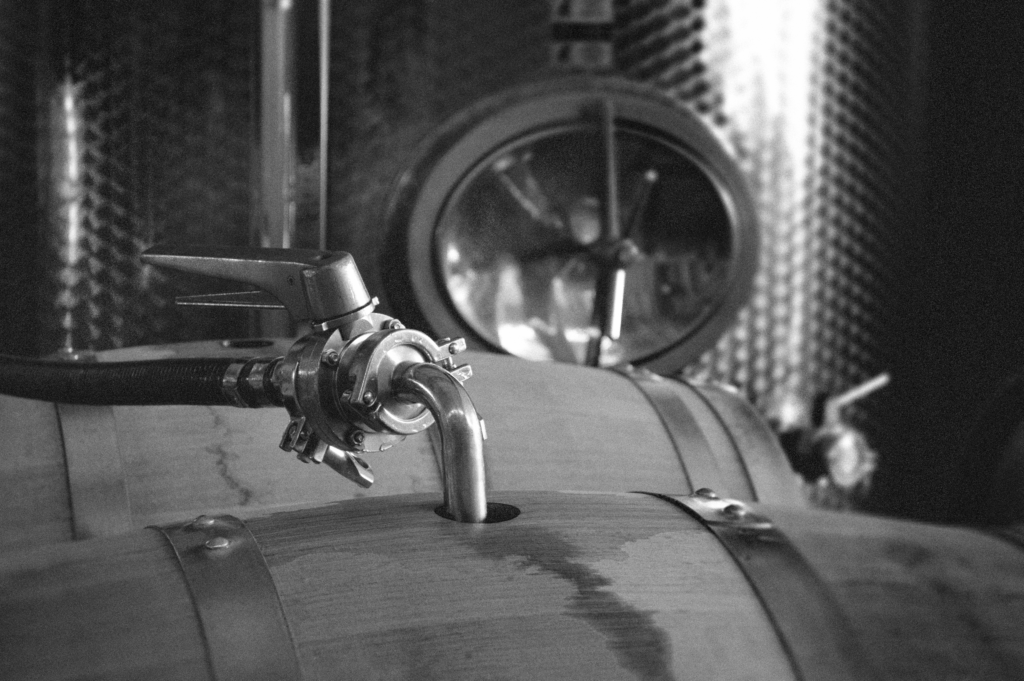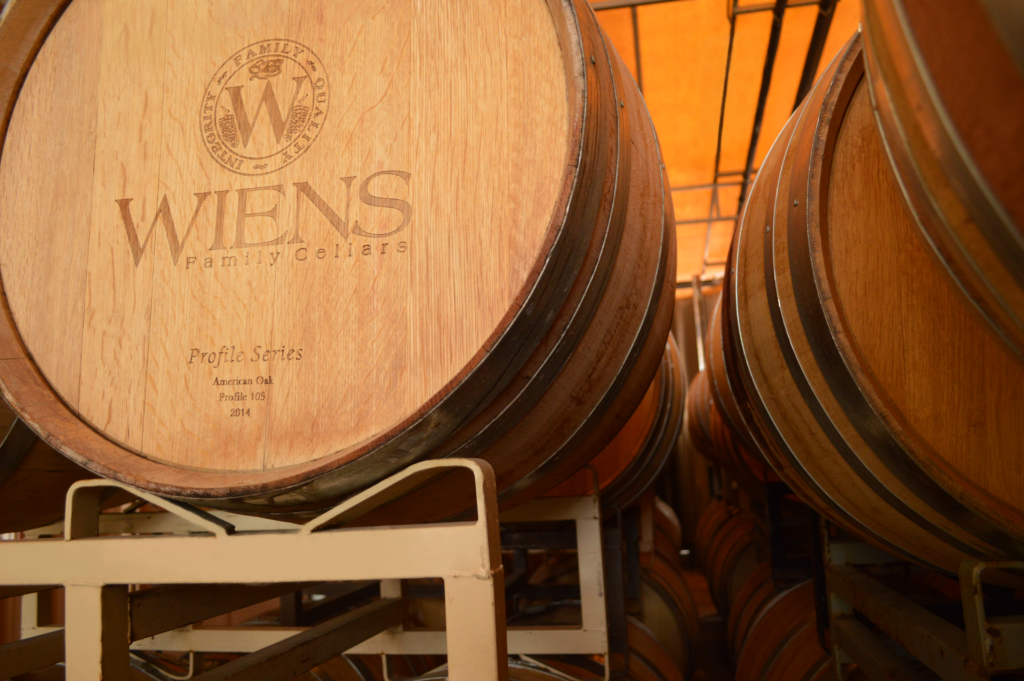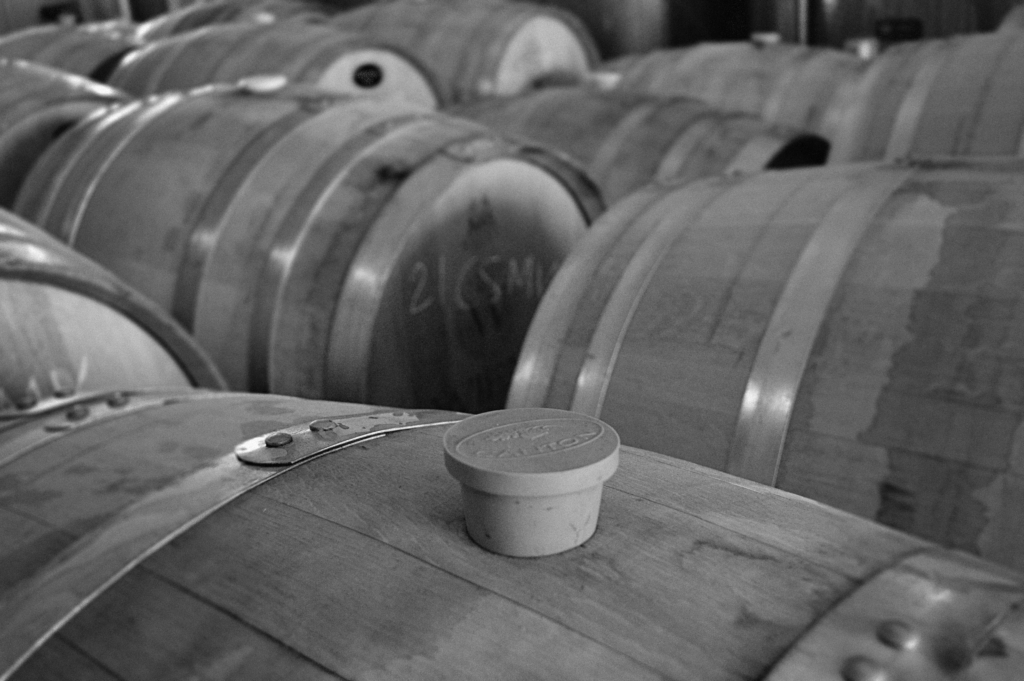Oak barrels are an essential tool in the winemaker’s arsenal, a vessel that has been used for centuries to shape and enhance the flavors and aromas of wine. From imparting subtle vanilla notes to adding complexity and texture, oak barrels play a pivotal role in the art of winemaking.
The history of oak in winemaking dates back to ancient times. The Greeks and Romans were among the first to recognize the benefits of oak barrels, using them to transport and age their wines. Over the centuries, winemakers refined the use of oak, and today, it remains an integral part of the winemaking tradition.
Why Oak?
The choice of oak in winemaking isn’t a random decision; it’s a deliberate one driven by an understanding of the unique properties that oak brings to the table. At Wiens Cellars, this understanding is woven into the very fabric of their winemaking philosophy.
The Unique Properties of Oak Wood
- Porous Nature: Oak wood is porous, allowing the wine to breathe. This slow exchange of air helps in micro-oxygenation, a process where oxygen interacts with the wine, contributing to its aging and flavor development.
- Flavor Compounds: Oak contains a treasure trove of flavor compounds such as lignin, vanillin, and lactones. These compounds infuse the wine with a range of flavors, from vanilla and caramel to spices and coconut.
- Tannin Structure: The tannins in oak barrels interact with the tannins in wine, softening and refining them. This interaction is essential for achieving a harmonious and balanced wine structure.
- Texture Enhancement: The fine-grained structure of oak wood contributes to the wine’s texture. It imparts a silky smoothness, making the wine more pleasurable on the palate.
- Microbial Environment: The inner surface of oak barrels harbors beneficial microorganisms that influence the wine’s development. These microorganisms can impart complexity and unique characteristics to the final product.
Brian Marquez, the winemaker at Wiens Cellars, underscores the significance of oak, saying, “Oak isn’t just a tool; it’s an essential component in crafting wines with character and depth. It adds complexity, structure, and a touch of artistry to the winemaking process.”
How Oak Influences Wine Flavor, Texture, and Longevity
The magic of oak lies in its ability to transform a simple grape juice into a complex and nuanced wine. Here’s how it impacts wine flavor, texture, and longevity:
- Flavor Profile: The natural compounds in oak wood seep into the wine, enhancing its flavor profile. French oak contributes delicate notes of vanilla, baking spices, and finesse, while American oak offers robust flavors of caramel, coconut, and dill. This infusion of flavors elevates the wine’s aromatic bouquet and taste.
- Texture and Mouthfeel: The fine-grained nature of oak lends a desirable texture to the wine. It smooths rough edges, harmonizes tannins, and rounds out the palate, resulting in a more balanced and enjoyable drinking experience.
- Longevity: Oak barrels provide a controlled environment for wine aging. Oxygen permeates through the wood slowly, allowing the wine to evolve and mature gracefully over time. This extended aging potential is particularly crucial for wines that are meant to be cellared for years.
David Steinhafel, owner of Wiens Cellars, emphasizes the role of oak in crafting their signature wines, saying, “Oak is our silent partner in the cellar. It’s the bridge that connects the fruit from our vineyards to the final bottle. Its influence is undeniable and vital.”
Types of Oak Used in Winemaking
The choice of oak isn’t limited to a single variety; winemakers must decide between European oak, American oak, and other variations, each imparting its unique character to the wine.
Differences Between European Oak, American Oak, and Other Varieties
- European Oak: European oak, primarily sourced from French and Hungarian forests, is renowned for its elegance and subtlety. Wines aged in French oak barrels often exhibit refined flavors of vanilla, baking spices, and a delicate structure. Hungarian oak, less common but equally fascinating, can introduce notes of cloves and exotic spices.
- American Oak: American oak is synonymous with boldness and robustness. It imparts flavors of caramel, coconut, and dill, along with a more significant tannin presence. Wines aged in American oak barrels tend to be more assertive, with a pronounced oak character.
- Other Varieties: Beyond European and American oak, winemakers also explore oak from various regions like Russian oak and Canadian oak. Each oak variety introduces its own nuances, contributing to the diversity of wine styles.
Regional Differences and Their Impact on Wine
The region where oak is grown also influences its properties. French oak from the Allier forest, for instance, is prized for its fine grain and tight grain structure. Wines aged in Allier oak tend to exhibit delicate flavors and smoother tannins. In contrast, oak from the Tronçais forest, also in France, offers a coarser grain, resulting in a more pronounced oak influence.
Brian Marquez, the winemaker at Wiens Cellars, elaborates, “Selecting the right oak variety and region is a crucial decision. It’s about finding that perfect match between the grape variety, terroir, and the oak’s unique characteristics. At Wiens Cellars, we approach this selection with the utmost care and consideration.”
In conclusion, oak barrels aren’t just containers; they’re the silent architects of wine. They transform grapes into extraordinary experiences, and at Wiens Cellars, this transformation is a craft, an art, and a testament to the enduring partnership between oak and winemaking.
The Process of Barrel Making
Cooperage is the craft of creating oak barrels, a process that requires skill and precision. Experienced coopers select oak logs, age the staves, and carefully shape them into barrels. Traditional methods ensure the highest quality, as the craftsmanship is passed down through generations.
The significance of toasting levels in barrels
Toasting levels refer to the process of charring the inside of the oak barrel. This step can significantly impact the wine’s flavor. Light toasting provides subtle notes of vanilla, while heavy toasting imparts smoky, caramelized flavors. Winemakers carefully choose the toasting level to align with their wine’s desired profile.
Oak Barrels at Wiens Cellars
Wiens Cellars, nestled in the picturesque Temecula Valley of California, boasts a rich tradition of winemaking that harmoniously blends innovation with respect for the region’s terroir. At the heart of their winemaking journey lies a critical element: oak barrels. The choice of oak barrels at Wiens Cellars plays a pivotal role in crafting wines that are not only a testament to the art of winemaking but also a celebration of the unique character of the Temecula terroir.
The winemaking team at Wiens Cellars recognizes that the type of oak used in barrels profoundly influences the flavor profile, texture, and overall quality of their wines. They employ a careful selection process, focusing primarily on French and American oak. French oak barrels, renowned for their elegance, impart a subtle finesse to the wines. These barrels, often sourced from the forests of Allier and Tronçais, lend delicate notes of vanilla, baking spices, and a refined structure to the wines. American oak, on the other hand, contributes robust flavors of caramel, coconut, and dill, imparting a bold and distinctive character to the final product.
Brian Marquez, the passionate winemaker at Wiens Cellars, emphasizes, “Our oak barrels are chosen with the utmost care, ensuring they align perfectly with the grape varieties we cultivate. This meticulous selection process is the cornerstone of our winemaking philosophy, ensuring that each wine showcases the ideal balance of oak influence, fruit expression, and regional character.”
David Steinhafel, owner of Wiens Cellars, adds, “We view the use of oak as an art form. It’s about understanding how oak interacts with our wines, bringing out the best in each varietal while preserving the distinct identity of Temecula Valley.”
The use of oak barrels at Wiens Cellars extends beyond mere aging; it’s a partnership between tradition and innovation, where each barrel contributes its unique story to the wine. Oak is not just a vessel; it’s an instrument in the symphony of flavors that define Wiens Cellars’ exceptional wines.
How Oak Influences Wine
Understanding how oak influences wine is akin to unraveling the secrets of a complex symphony. Oak barrels impart a myriad of characteristics, ranging from subtle nuances to bold, defining notes. Here’s a deeper dive into how the interaction between oak and wine shapes the final product:
- Flavor Compounds: Oak is teeming with natural compounds such as lignin, vanillin, and lactones. During aging, wine slowly extracts these compounds, adding layers of flavor and aroma. Lignin, for instance, contributes to the wine’s structure and mouthfeel. Vanillin imparts those delightful vanilla notes, while lactones introduce soft, coconut-like flavors. At Wiens Cellars, this extraction process is a fine-tuned dance, ensuring the perfect balance of these elements.
- Wine Maturation: Oak barrels provide a controlled environment for wine to mature gracefully. Oxygen slowly permeates the wood, facilitating subtle oxidation. This oxygen interaction softens tannins, rounds out sharp edges, and allows complex chemical reactions to unfold. The result is a wine that evolves, gaining complexity, depth, and the potential for extended aging.
- Oak Influence on Texture: The use of oak also influences the texture of the wine. Fine-grained oak imparts a smoother, silkier mouthfeel. The tannins in the wood bind with those in the wine, leading to a more integrated and refined structure. This interplay between tannins and oak texture is a delicate art, honed by winemakers like Brian Marquez at Wiens Cellars.
Oak is not just a passive vessel but a dynamic partner in the winemaking process. It adds layers of complexity, contributing to the wine’s overall character. As David Steinhafel, owner of Wiens Cellars, aptly puts it, “The art of using oak in winemaking lies in understanding when to let it shine and when to let the grapes express their natural beauty. It’s about elevating the wine without overpowering it.”
In the world of winemaking, oak barrels are akin to the artist’s brush, adding depth, texture, and character to the canvas of wine. The journey of a grape from vine to barrel is a journey of transformation, guided by the expertise of our winemakers and the embrace of oak’s influence.
As you savor a glass of Wiens Cellars wine, take a moment to appreciate the legacy of oak that lingers in every sip. It’s a testament to the timeless tradition of winemaking and the artistry that defines our craft.
In our next exploration, we’ll delve into the intriguing world of terroir, uncovering the secrets of how the land itself shapes the character of our wines.



